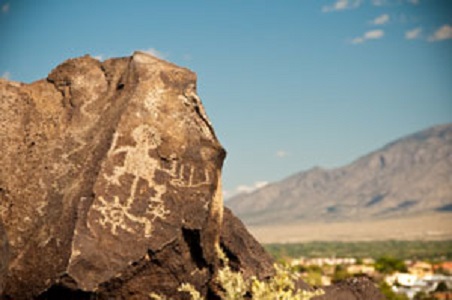
Courtesy of Paigeh through Flickr's Creative Commons
Approximately 130,000 years ago, lava poured from a crack in the earth today located in New Mexico, west of Albuquerque. As it cooled, this lava created a 25,000-foot thick sheet of rock. Later, volcanoes and other forces shaped the rock into a long ridgeline. Here, groups of both American Indians and Spanish settlers carved messages and religious symbols into the ancient volcanic rock. On a network of trails, visitors to Petroglyph National Monument can explore this land with its volcanoes, archeological sites, and some 24,000 carvings of animals, people, brands, crosses, and other images that still have meaning for people today.
Trails for moderate to strenuous hikes at Boca Negra Canyon, Rinconada Canyon, and Piedras Marcadas Canyon, offer views of the petroglyphs. The volcanoes area in the park shows more of the natural features of the park. A visitor center provides information about the trails and special activities within the park. The visitor center is housed in the adobe-style former home of Dr. Sophie Aberle, an early anthropologist.
The petroglyphs are carved directly into the surface of the rock, chipped off by chisel and other stones. The ancient Puebloans created most of the petroglyphs. These ancestors of today’s Pueblo Indians lived in the area around the Rio Grande for more than 1,500 years. Around 1300 AD, the population of the Puebloans increased and new settlements were formed to accommodate this growth. As the population expanded throughout the Southwest, some groups settled on the lands that are included within the park where they, the Apache, and the Navajo appear to have created most of the petroglyphs between 1300 and the 1680s. The earliest petroglyphs are considerably older, dating from 2000 BC.
These petroglyphs are not just reminders of the heritage of American Indian peoples in the American Southwest. The petroglyphs also have contemporary religious and ceremonial meaning for some tribes. The orientation of a symbol relative to other symbols, parts of the landscape, or the horizon are significant, just as is the petroglyph itself. Some petroglyphs record important events for a family group or a tribe, while others have much more personal, private meanings.
American Indian tribes consider the images and the land within Petroglyph National Monument to be a sacred space. Visitors to the park are encouraged to observe the petroglyphs, but not to touch them; touching the carvings or other surfaces of the rocks is forbidden, as this will disturb their patina. Once this happens, the original petroglyph can be eroded and lost. A patina, or coating, forms on the surface of the rocks over time. Those who carved the petroglyphs chipped away at this patina, also called desert varnish, to create the images we see today.
The Ancient Puebloans were not the only ones who carved images and symbols into the rocks of the desert around Albuquerque. Spanish settlers who arrived in the area beginning in the 1540s also created petroglyphs. The earliest Spanish were not settlers, but explorers looking for land suitable for future settlements. Having found good land along the Rio Grande, these explorers provided reports back to Spain that encouraged others to come and settle. For roughly 80 years, between 1600 and 1680, the Spanish moved into the area, creating a farm and ranch system along the Rio Grande.
During the Pueblo Revolt in 1680, the native Puebloans in the area rebelled against the forced labor and the Catholicism the Spanish imposed on them. For 12 years, American Indians again controlled a large amount of land in present-day New Mexico before Spanish forces retook the land. Don Diego de Vargas, who succeeded in reoccupying New Mexico for the Spanish, recognized the contributions of one man who fought for the Spanish, Don Fernando Duran y Chaves II, by giving him more than 80,000 acres west of the Rio Grande. Spanish settlement in the area of the park resumed and the amount of land given to Don Fernando increased through additional grants. Within the area of the grant, known as the Atrisco Land Grant, the Spanish settlers carved petroglyphs just as the Puebloans had. The Spanish petroglyphs were usually Christian symbols, replicas of livestock brands, or a set of initials.
After New Mexico became part of the United States in 1848, the American Indian and Spanish carvings became a part of the American story. The social and cultural roots of Petroglyph National Monument are much older than the United States, though. The park protects the land, the sites, and the petroglyphs and makes them accessible to those who value them today.
Petroglyph National Monument, a unit of the National Park System, is located in Albuquerque, NM. Visitors are recommended to begin their tour at the visitor center located off Unser Boulevard on Western Trail. The visitor center is open daily from 8am to 5pm and is closed on Thanksgiving, Christmas, and New Year’s Day. Each trail has different opening hours. More information and directions to the trails mentioned above may also be found here. There is no fee to visit the park, although there is a fee to park at the Boca Negra Canyon site. For more information, visit the National Park Service Petroglyph National Monument website or call 505-899-0205.
While in Albuquerque, visitors may also explore historic Route 66 featured in the National Park Service Route 66 Travel Itinerary.
Last updated: August 24, 2017
